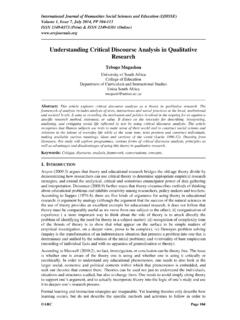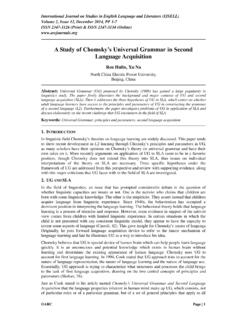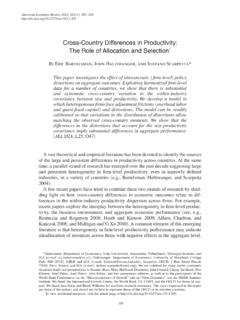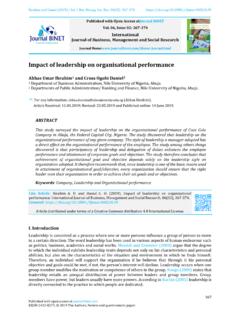Transcription of Managing Communication Challenges in Multicultural ...
1 International Journal of Media, Journalism and Mass Communications (IJMJMC) Volume 4, Issue 2, 2018, PP 44-49 ISSN 2454-9479 International Journal of Media, Journalism and Mass Communications (IJMJMC) Page| 44 Managing Communication Challenges in Multicultural Organizations Shafaat Hussain* Assistant Professor of Journalism and Communication , MaddaWalabu University, Bale-Robe, Oromiya Region, Ethiopia 1. INTRODUCTION Multiculturalism is a reality the way world is globalized in the social sphere, political system, economic landscape, geographical areas, and international relations.
2 Multicultural organizations (MCOs hereafter)are omnipresent in the current economic system; and we are persistently surrounded by diverse cultures; therefore, workforce diversity is becoming the common feature of the MCOs. The size and number of the organizations operating across the globe is also growing very fast. Consequently, the diversity is more in the consumer base, client groups, and partners (Sudhiir and Sudhiir, 2016:95). An organization wherein the people of diverse culture work together in order to achieve certain common goals is known as a Multicultural organization.
3 MCOs are the hubs of various cultures hailing from across the world. At the present time, these MCOs possess a larger proportion of organizational workforce throughout the world s economy. Since this workforce has huge potential to organizations improving their effectiveness in the global business environment, they require deep understanding of mixed skills of employees from different nations. (Cox, 1993; Galbraith, 2000; Kirchmeyer and McLellan, 1991; Kirkman and Shapiro, 2001; Tung,1993). There are many instances of cultural variants in the different parts of the world. Knowing these differences can simplify the functions of both multinational employers and employees.
4 Knowing the cultural diversity helps in team building, trust formation, conflict resolution, effective collaboration, and more importantly assess the performance of the team members (Binder, 2007; McDonough, 2001:111).For example, East Asians presume that the people from Western countries treat strangers like friends; and friends like strangers. Communication in Western cultures is generally direct and explicit. The meaning of the message is very clear. But, this isn't the case in other countries, like Japan, where formality and etiquettes play a major role in their Communication .
5 For some cultures, eye contact is considered as discourteous while for others refraining from the same is considered as disrespectful. Further, in Western cultures, and in Africa, giving a hug is considered very informal and fine but it may not be so in Asian countries. Furthermore, some cultures treat women as subordinate and for men belonging to such cultures it becomes near impossible to working shoulder to shoulder or having women as their superiors. Additionally, in some cultures the appropriate greeting is a handshake, in others a bow, in others an embrace. It is cited in a study that Arabs, Latin Americans Abstract: Multicultural organizations are the hubs of various cultures hailing from across the world.
6 Managing Communication Challenges in culturally diverse global teams is indeed a herculean task. Effective Communication in Multicultural organizations is similar to a human neural network; and once it fails the entire system gets dysfunctional. In a Multicultural organization, Communication is a powerful tool through which information is exchanged; trust is built; and constructive relationship is maintained. This paper primarily reviews the literatures on the concept of Multicultural organizations. The second section deals with the available opportunities for Communication in a Multicultural set-up.
7 The third part discusses the various dimensions of Communication in a Multicultural organization. The fourth section argues the possible Challenges of Communication in a Multicultural organization. And, the final section proposes the ways, how Multicultural organizations manage their Communication Challenges . Keywords: Communication , Multicultural Organization, Cross-Cultural, Stereotyping, Ethnocentrism. *Corresponding Author: Shafaat Hussain, Assistant Professor of Journalism and Communication , MaddaWalabu University, Bale-Robe, Oromiya Region, Ethiopia Managing Communication Challenges in Multicultural Organizations International Journal of Media, Journalism and Mass Communications (IJMJMC) Page| 45 and Southern Europeans look into the eyes of conversational partners whereas Asians and North Europeans only use a peripheral gaze or no gaze at all during interactions.
8 Silence is indicated as respect among Chinese people while it is interpreted as shyness or lack of interest among Australians. Similarly, touch has different meanings in different cultures. In Thailand it is considered rude to touch to strangers; whereas in Ethiopia, walking hand in hand with friends and opposite sex indicates a romantic relationship (Sudhiir and Sudhiir, 2016:97). Thus, difference in Communication approaches, understandings, attitudes, and styles, is inevitable phenomenon among the diverse workforce of MCOs. 2. FEATURES OF MCOS The literature is both consistent and clear in demonstrating the power and potential of the MCOs.
9 The prominent features of MCOs are that they hire the best available human talent; possess high morale, and collective positivity among workers; have broader perspectives and deeper ideas; and hold open-mindedness and tolerance. Moreover, MCOs are more efficient and productive; technologically more sound; more competitive; and higher in creativity and innovation due to their diverse background. In addition to it, they have sound relationships with key partners in foreign markets; and encompass greater problem solving ability. Equipped with the better decision making abilities, MCOs exhibit change and flexibility, and they have large virtual network (Kiss, 2005:220; Singh, 2014:46; Vashishtha & Garg, 2014:3-4; Heyman 2017:21).
10 3. CONCEPTUALIZING Communication IN MCOS Organizational Communication is the study of Communication within organizations. The flow of Communication within an organization is multifaceted: formal and informal, vertical and horizontal, verbal and non-verbal, and written and oral. Managing Communication in a MCO is indeed a herculean task. Communication in Multicultural organizations is like a neural network in the human body; and if there is a fall through, the organism becomes inefficient or even dysfunctional. Similarly, in a Multicultural organization, it is only through the effective Communication that the information is shared, trust is built, and constructive relation is developed and maintained.








